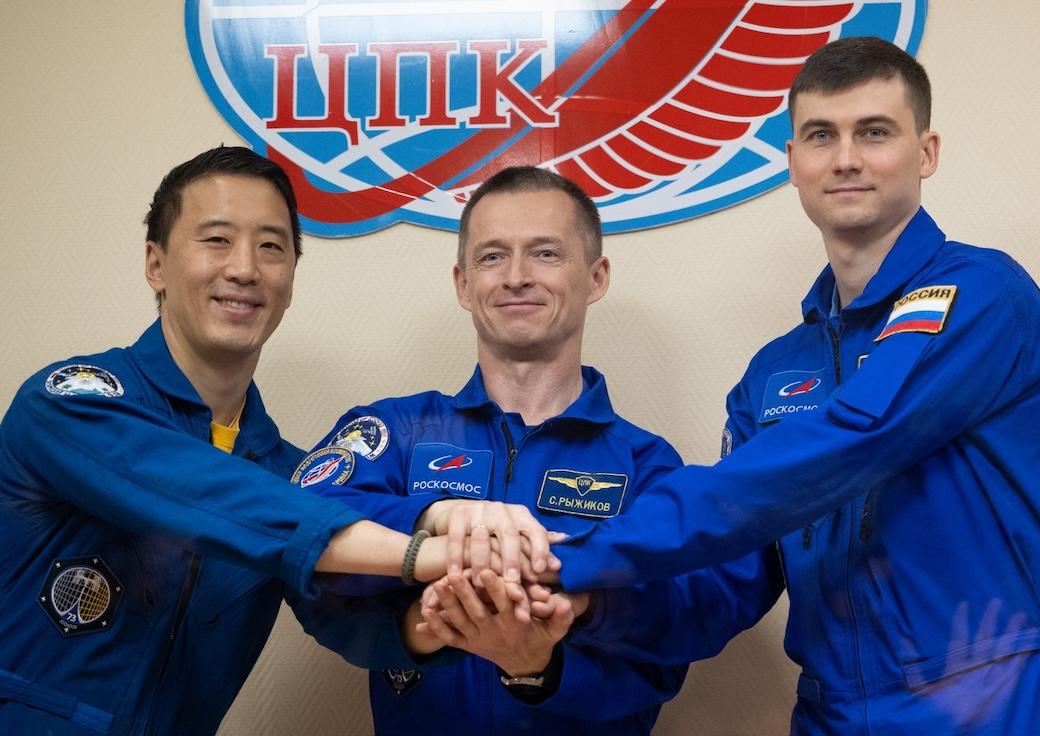This article is published in Aerospace Daily & Defense Report part of Aviation Week Intelligence Network (AWIN), and is complimentary through May 09, 2025. For information on becoming an AWIN Member to access more content like this, click here.

NASA astronaut Jonny Kim, left, and Roscosmos cosmonauts Sergey Ryzhikov and Alexey Zubritskiy are at the Cosmonaut Hotel in Baikonur, Kazakhstan, the day before their launch tothe International Space Station.
HOUSTON—Russia’s Soyuz MS-27 launched to and docked with the International Space Station (ISS) early April 8, transporting NASA astronaut Jonny Kim and cosmonauts Sergey Ryzhikov and Alexey Zubritsky as part of the final phase of the Expedition 72/73 crew exchange aboard the orbital lab.
The MS-27 autonomously docked to the Earth-facing port of the ISS Russian segment’s Prichal module at 4:57 a.m. EDT, following its launch atop a Soyuz-2.1a rocket from the Baikonur Cosmodrome in Kazakhstan at 1:47 a.m. EDT.
Prepared for an eight-month ISS stay, the newcomers were greeted by NASA astronauts Anne McClain, Nichole Ayers and Don Pettit; Japan Aerospace Exploration Agency astronaut Takuya Onishi; and cosmonauts Alexey Ovchinin, Ivan Vagner and Kirill Peskov.
Kim, Ryzhikov and Zubritsky will replace Ovchinin—the current ISS commander—along with Vagner and Pettit, who are to depart for Earth aboard the Soyuz MS-26 on April 19. The departure will end Expedition 72, with a shift in command for Expedition 73 to Onishi. The MS-26 launched to the ISS on Sept. 11, 2024.
McClain, Ayers, Onishi and Peskov launched aboard NASA’s Crew-10 Dragon mission to the ISS on March 14, to begin the current crew exchange. They replaced NASA’s Nick Hague and the agency’s Boeing CST-100 Starliner Crew Flight Test extended-mission astronauts Barry “Butch” Wilmore and Sunita “Suni” Williams as well as cosmonaut Alexsandr Gorbunov. They returned to Earth aboard the Crew-9 Dragon spacecraft with a parachute-assisted splashdown and recovery in the Gulf of Mexico off Florida on March 18.
NASA selected Kim, a U.S. Navy lieutenant commander, medical doctor and former Navy SEAL, for astronaut training in 2017. He is beginning his first mission to space.
As part of his mission, Kim is a subject in NASA’s Complement of Interrelated Protocols for Human Exploration Research, a full-body medical research effort initiated in 2023 to study how a range of astronaut types respond physically and mentally to spaceflights of varying durations, to help prepare for human deep-space exploration.
“It’s going to answer a lot of questions we have before we start committing ourselves to long-duration, multi-year spaceflights to Mars and beyond,” Kim said during a pre-launch news briefing.”
Kim also expressed enthusiasm for the opportunity to participate in the wide-ranging research underway aboard the ISS in a collaborative multinational setting. “To me and many of my colleagues, the ISS is the most incredible feat of human engineering that transcends the borders that humanity has ever created, and we get to live and work on it every day,” he said.
Ryzhikov, a military pilot, has logged 358 days in space over two missions to the ISS in 2020-21 and 2016-17 and participated in one spacewalk. Zubritsky, a military pilot selected for cosmonaut training in 2018, also is participating in his first space mission.
As part of Expedition 73, the MS-27 crew will participate in the 226 scientific research and technology development activities underway as well as ISS maintenance. Spacewalks outside the U.S. segment are planned to continue the installation of new Roll Out Solar Arrays as part of a solar power-generation upgrade that began in 2021. Upgrades to the Alpha Magnetic Spectrometer, a cosmic-ray and antimatter observatory installed in May 2011, also are planned.





